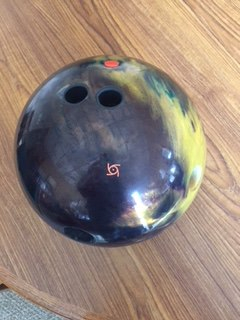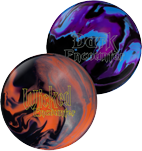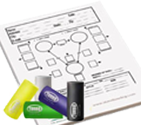
The SON!Q
Review Date: 14 August 2018
Reviewed by:
Storm/Roto Grip staffer John Brockland
Style: Stroker Rev Rate: 280-310
PAP: 5.50" over and 1" up
The
SON!Q
is
an
enhancement
in
the
super
successful
!Q
series,
which
first
made
a
huge
hit
at
the
professional
level
providing
unparalleled
smooth
and
controllable
ball
motion
on
tough,
flat
competitive
lane
patterns
with
its
uniquely
low
differential
and
minimized
flare
potential.
As
lane
oils
have
become
more
viscous
and
competitive
patterns
become
increasingly
difficult
to
navigate
through
the
front
and
midlane
there
was
perceived
a
need
for
a
tweak
to
what
had
been
so
good
for
so
long.
That
original
Centripetal
Core
appears
here
in
its
most
newly
evolved
state
–
the
Centripetal
HD
(high
density)
Core.
When
it
was
released
on
February
9th,
it
was
the
densest
core
Storm
had
ever
manufactured.
It
has
an
RG
of
2.47
but
a
very
low
center
of
gravity
which
Storm
theorized
would
keep
pins
low
on
impact
and
enhance
carry
potential.
This
new
core
is
wrapped
with
the
ever-popular
R2S
Pearl
Reactive
cover,
which
keeps
it
clean
through
the
front
part
of
the
lane
in a
way
everyone
hopes
for
from
a
symmetrical
pearl.
The
core
in
this
case,
though
increased
dynamically
from
its
predecessors,
still
keeps
ball
motion
at
the
end
of
the
pattern
predictable
in
keeping
with
the
longstanding
reputation
of
the
!Q
series.
For
a
layout
on
my
SON!Q
I
went
with
my
standard
and
favorite
high
pin
layout.
The
specs
are
55 x
5.25
x
45,
and
because
my
ball
speed
has
diminished
over
the
years
I
tend
to
roll
that
layout
upward
relative
to
my
grip
center
just
a
bit
to
give
me a
little
easier
length.
This
ends
up
creating
a
pin
buffer
of
about
2.5
inches
from
my
VAL.
It
is
static
legal
both
under
old
and
new
specifications
tolerances
without
a
balance
hole.
The
SON!Q
was
a
real
head-turner
out
of
the
box,
as I
have
found
often
to
be
the
case
with
fresh
R2S
pearl
covers.
The
first
few
trips
down
the
lane
in
practice
before
league
on a
regular
STL
house
shot
made
the
ball
look
like
King
Kong
down
lane.
Once
the
cover
started
absorbing
a
little
oil
and
calming
down
a
bit,
the
truer
performance
characteristics
of
the
ball
came
through
loud
and
clear.
The
hyper-responsive
behavior
when
it
sniffed
dry
went
away
and
what
I
have
had
ever
since
then
from
the
SON!Q
is
exactly
what
Storm
described
as
its
design
intention;
namely,
a
perfect
evolution
in
!Q
series
performance
adapted
to
accommodate
the
evolution
in
patterns
with
heavier
and
tighter
mid-lanes.
The
most
notable
way
the
SON!Q
demonstrates
that
intention
is
in
the
increased
flare
potential
with
traditional
!Q
differential
of
0.029
elevated
here
to
0.045.
In
tournament
situations
I
have
found
the
SON!Q
to
be a
perfect
second
step
in a
migration
of
ball
changes
as
lanes
transition.
It
is
strong
enough
to
handle
some
volume
but
is
clean
enough
through
the
front
to
allow
me
to
migrate
more
slowly
and
keep
my
launch
angles
from
getting
too
steep
too
quickly
in
the
course
of a
long
block
of
games.
In
that
regard,
for
example,
it
was
great
for
me
at
the
MO
USBC
Open
Championships
(State
Tournament)
this
past
year
as a
go-to
after
the
pin-down
MATCH
UP
SOLID
that
I
started
Doubles
&
Singles
with
wouldn’t
corner
enough
anymore.
The
down-side
for
me,
if
you
want
to
call
it
that,
is
that
the
performance
of
the
SON!Q
down
lane
is
still
smooth
enough
that
when
I
get
past
20-board
or
so I
find
I
have
to
go
to
something
with
a
more
dynamic
core
to
retain
the
hitting
power
and
entry
angle
I
need
with
my
less-than-enough
hand
and
axis
tilt.
For
someone
who
is
primarily
a
league
bowler
in
the
STL,
there
is
very
little
way
you
could
go
wrong
with
a
SON!Q.
You
may
have
to
do a
little
surface
adjustment
to
fine-tune
it
for
your
particular
center’s
house
pattern,
but
it
should
perform
well
for
just
about
anyone.
For
the
tournament
bowler,
the
SON!Q
should
prove
worth
of a
mid-range
spot
in a
6 or
8
ball
tournament
arsenal.
 |
||||||||||||||||||||||||||||||||
 |
||||||||||||||||||||||||||||||||




